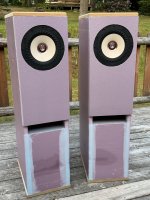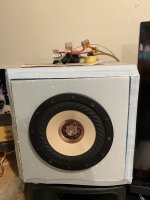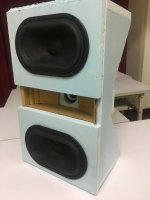I set the port at "the bottom" meaning the port is the last part of the line. A slotted port.
I was wondering if there was symmetry between port and driver placement. That is, if you were stuck with the driver being at one end of the line, could you put the port appx 1/3 of the way from the opposite end - to similar effect?
Unsure if the stuffing would "mirror image" as well.
in the German mag Hobby Hifi they actually proposed this (have the port inside height at 1/3 of cab height) to suppress the standing wave related to the cabinet height.... That is, if you were stuck with the driver being at one end of the line, could you put the port appx 1/3 of the way from the opposite end - to similar effect?
I would like to thank this thread since It validated what I was trying to do.
I had a pair of FaitalPro 3FE22 and did't want to make a Bass Reflex cabinet and was afraid that a TL or any kind of pipe was no going to work. Searching for mass loading a TL I found this thread a read all the 26 pages.
I designed an bigger box in winisd so that extensión would be lower, but there was a drop in the 100-150Hz that I was afraid would sound thin, so make the TL tunning to this zone. The results were quite good, I also found in this thread a way to add the bass reflex to hornresp. These are the results.
They would need step compesation if placed over a table but not if they are on the floor. They are really bassy, almost boomy if placed against walls, so no step copensation will be added. The gratest strenght is soundstaging, they are also non fatigating. I added a bit more polyfill and then glued them for good.
After these I will be building some 3 ways speakers.
Thanks. Regards.





I had a pair of FaitalPro 3FE22 and did't want to make a Bass Reflex cabinet and was afraid that a TL or any kind of pipe was no going to work. Searching for mass loading a TL I found this thread a read all the 26 pages.
I designed an bigger box in winisd so that extensión would be lower, but there was a drop in the 100-150Hz that I was afraid would sound thin, so make the TL tunning to this zone. The results were quite good, I also found in this thread a way to add the bass reflex to hornresp. These are the results.
They would need step compesation if placed over a table but not if they are on the floor. They are really bassy, almost boomy if placed against walls, so no step copensation will be added. The gratest strenght is soundstaging, they are also non fatigating. I added a bit more polyfill and then glued them for good.
After these I will be building some 3 ways speakers.
Thanks. Regards.
@xrk971 ,
I know this thread is kinda old, but interested in your MLTL prototyping technique. I'm a noob to speaker building, but want to build a TL speaker and from with I've read, seem they can be a bit finicky and require some trial and error.
FYI - I've had both your LSA Warp One amp and LSA 80 speakers - great stuff. Kinda a fan.
Questions:
- Do you still think foam core works well for prototyping?
- WRT a small floor stander. What about doing a plywood baffle and foam core the rest of the cabinet to rapid prototype?
- Or , maybe make the external plywood and use foam for internals to be able to adjust more rapidly?
Interested in your thoughts.
Also, are you going to Capital Audio Fest? Could I buy you coffee/lunch for some advice?
Let me know. Thanks.
I know this thread is kinda old, but interested in your MLTL prototyping technique. I'm a noob to speaker building, but want to build a TL speaker and from with I've read, seem they can be a bit finicky and require some trial and error.
FYI - I've had both your LSA Warp One amp and LSA 80 speakers - great stuff. Kinda a fan.
Questions:
- Do you still think foam core works well for prototyping?
- WRT a small floor stander. What about doing a plywood baffle and foam core the rest of the cabinet to rapid prototype?
- Or , maybe make the external plywood and use foam for internals to be able to adjust more rapidly?
Interested in your thoughts.
Also, are you going to Capital Audio Fest? Could I buy you coffee/lunch for some advice?
Let me know. Thanks.
Prototype with plywood baffle and foam core or XPS for rest of cabinet is great. I used real thin plywood on XPS for baffle of my 10F/RS225 for a long time until I switched to real all wood cabinets (which did not sound or measure any better).
Not sure if I will be at Capital Audio Fest.
Not sure if I will be at Capital Audio Fest.
I'll second X on the XPS thing... it's perfect for prototypes, easy to cut, cheaper than plywood.
Tis are not so finicky anymore with the tools available.
The defunct LeonardAudio TL and the very much supported HornResp made designing TL easier, taking out the trial and errors of years prior.
And if you really want to take the easy approach, X's 10F/RS225 is one of the better TL design to build out there.
Tis are not so finicky anymore with the tools available.
The defunct LeonardAudio TL and the very much supported HornResp made designing TL easier, taking out the trial and errors of years prior.
And if you really want to take the easy approach, X's 10F/RS225 is one of the better TL design to build out there.
@xrk971 and @perceval,
wow. X's 10F/RS225 might be a future project.
I'm starting simple. I did my first TL prototype of a bookshelf based on MarkAudio's Pluvia Seven 4" full range, some 3/4 inch foam and 1/4 plywood on baffle to do a quick and dirty photo (still need to trim the temp gasket). But I was pretty surprised at the sound this quick and dirty speaker could produce.
I was excited to start and used large cell styrofoam boards that were available... mistake. messy, and had to work to seal it but it worked. I covered it in vinyl just to cover the foam a bit. I will be changing foam boards going forward.
Do you have recommended foam boards you use? I was looking for something that may already have a thin plywood or skin layer would be ideal.
Thoughts? What do you guys use?


wow. X's 10F/RS225 might be a future project.
I'm starting simple. I did my first TL prototype of a bookshelf based on MarkAudio's Pluvia Seven 4" full range, some 3/4 inch foam and 1/4 plywood on baffle to do a quick and dirty photo (still need to trim the temp gasket). But I was pretty surprised at the sound this quick and dirty speaker could produce.
I was excited to start and used large cell styrofoam boards that were available... mistake. messy, and had to work to seal it but it worked. I covered it in vinyl just to cover the foam a bit. I will be changing foam boards going forward.
Do you have recommended foam boards you use? I was looking for something that may already have a thin plywood or skin layer would be ideal.
Thoughts? What do you guys use?
It would be some feat of marketing to convince your customers that speakers professionally constructed of such materials sound every bit as good as those made from the heavier stuff. Someone would save on shipping.Foamular pink XPS foam insulation boards from Owens Corning works well. You can glue thin plywood on it. Or use paper faced foam core board. Very thin but with bracing works quite well. Elmers brand is extra strong.
My measurements show that the XPS foam cabinet measures as good, if not better than 3/4in BB plywood. It really is lighter and has more self damping. Requires extra bracing but that’s not hard.
https://www.diyaudio.com/community/threads/10f-8424-rs225-8-fast-waw-ref-monitor.273524/post-6034251
XPS foam cabinet:

BB plywood cabinet:

The both sound great. I think if I worked harder on bracing the XPS box, the HD below 100Hz could be improved.
https://www.diyaudio.com/community/threads/10f-8424-rs225-8-fast-waw-ref-monitor.273524/post-6034251
XPS foam cabinet:
BB plywood cabinet:
The both sound great. I think if I worked harder on bracing the XPS box, the HD below 100Hz could be improved.
Last edited:
I use a combination of 3M spray glue and silicone sealant for making sure there's no air gap.
I used XPS for TLC, for OB and for sealed prototypes.
The latest example being the W6-2313.
Not the best job at cutting and assembling the pieces, as I tend to move quick and dirty 'cos I can't wait to hear how it sounds!
I used XPS for TLC, for OB and for sealed prototypes.
The latest example being the W6-2313.
Not the best job at cutting and assembling the pieces, as I tend to move quick and dirty 'cos I can't wait to hear how it sounds!
Attachments
@perceval ,
I am with you. I can’t wait to hear the speakers, so edges may not be perfect, but sealant cures that.
Isn’t that what prototyping is for? Get a quick fair estimate of what the final build will sound?
I’m trying an experiment on my next proto. Found these foam boards at craft store that have paper on one side - cork on the other. My hope is the out skins provide more stiffness and with cork on inside, some dampening as well:
https://www.michaels.com/product/elmers-cork-foam-board-10265445
Thoughts?
I am with you. I can’t wait to hear the speakers, so edges may not be perfect, but sealant cures that.
Isn’t that what prototyping is for? Get a quick fair estimate of what the final build will sound?
I’m trying an experiment on my next proto. Found these foam boards at craft store that have paper on one side - cork on the other. My hope is the out skins provide more stiffness and with cork on inside, some dampening as well:
https://www.michaels.com/product/elmers-cork-foam-board-10265445
Thoughts?
- Home
- Loudspeakers
- Full Range
- Accidental MLTL Technique


